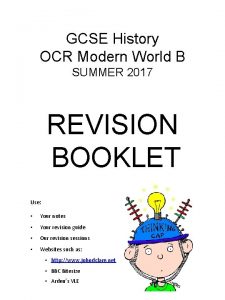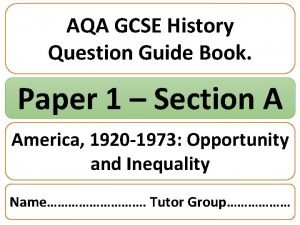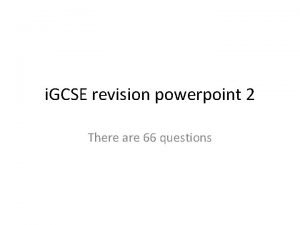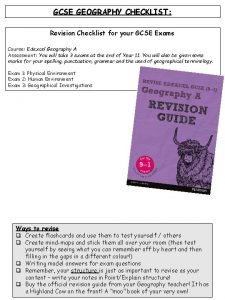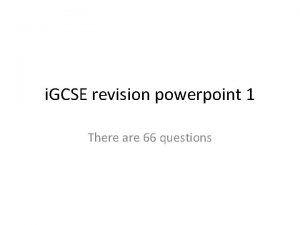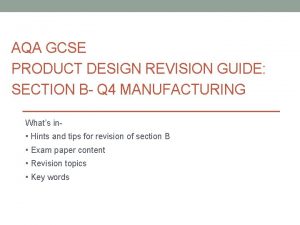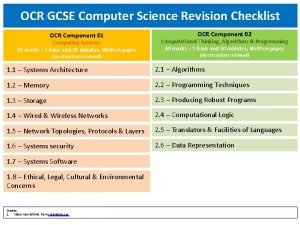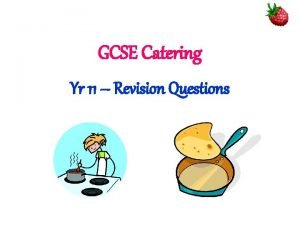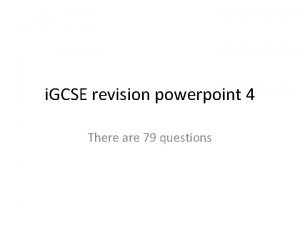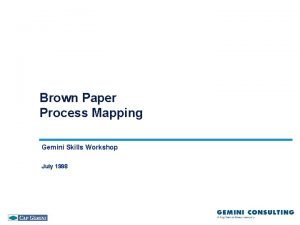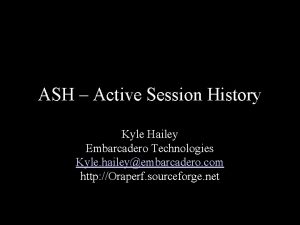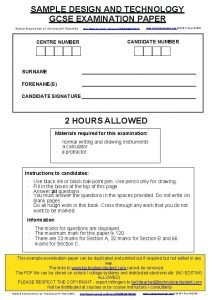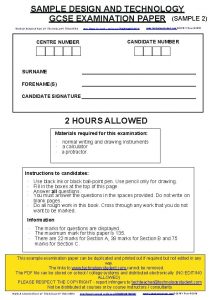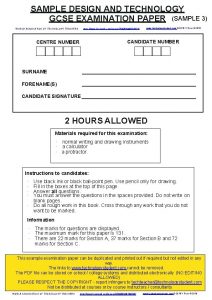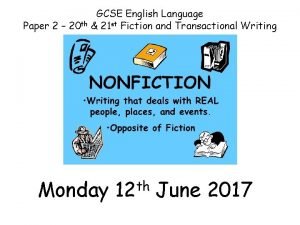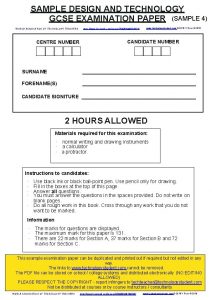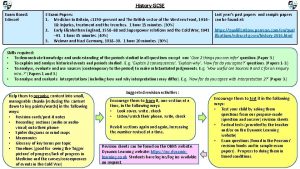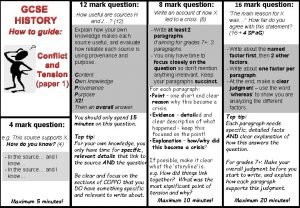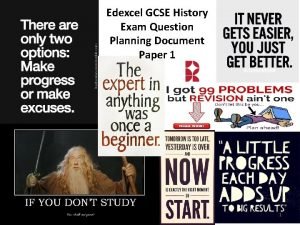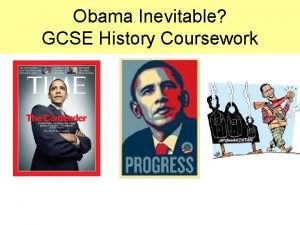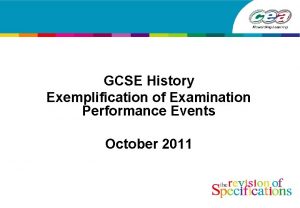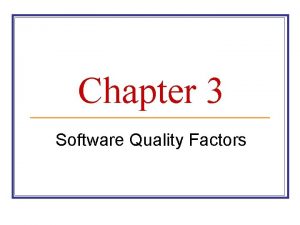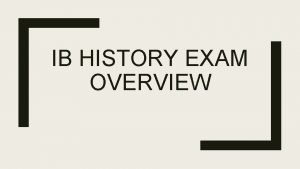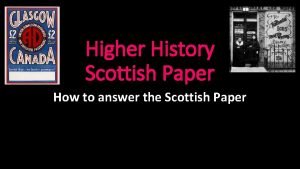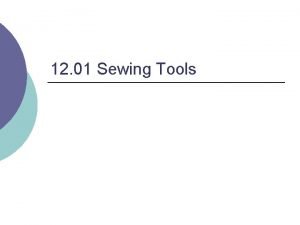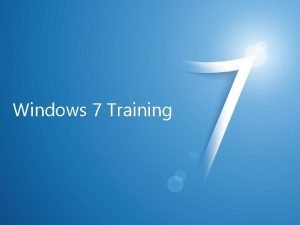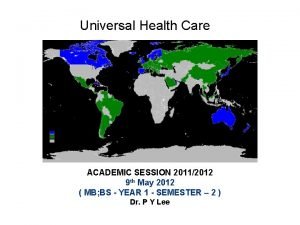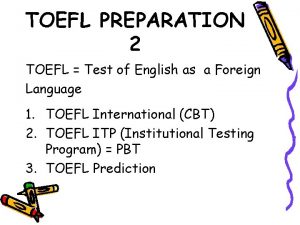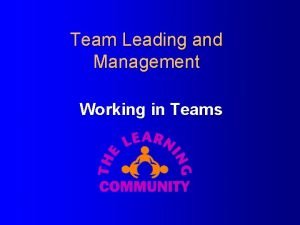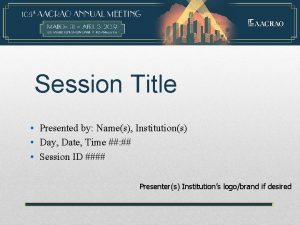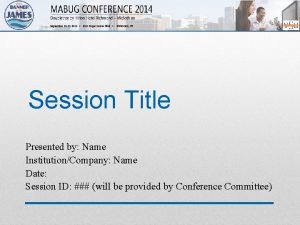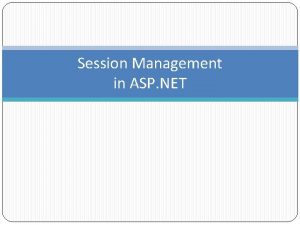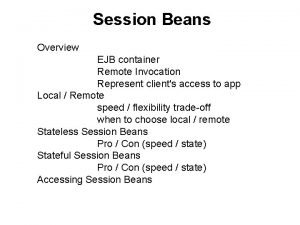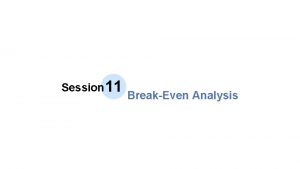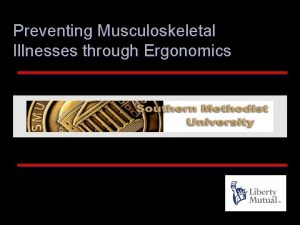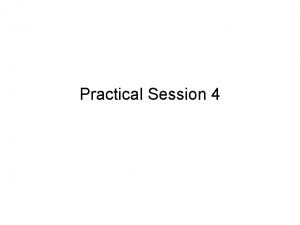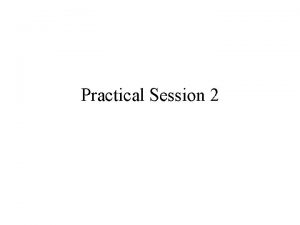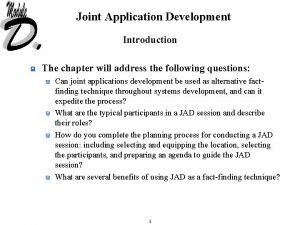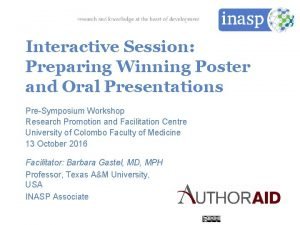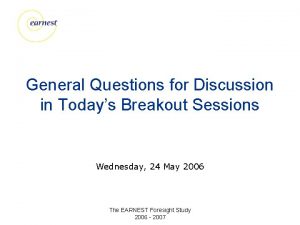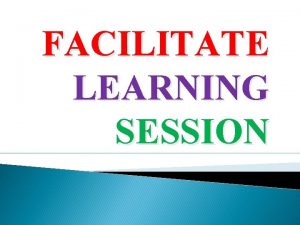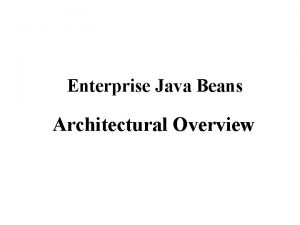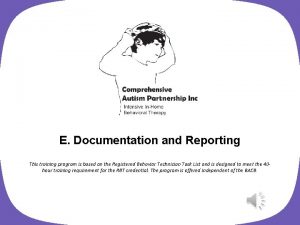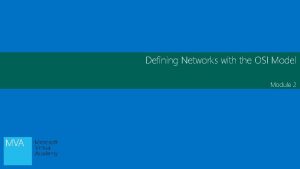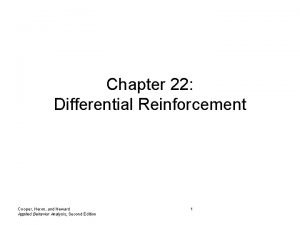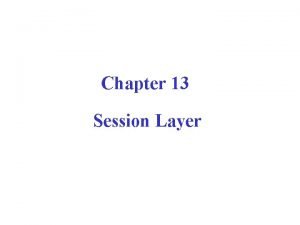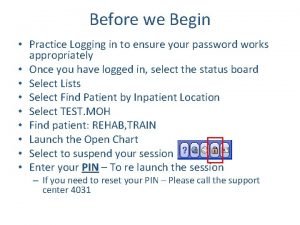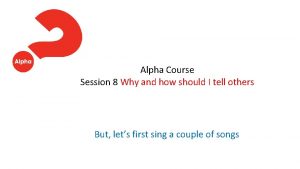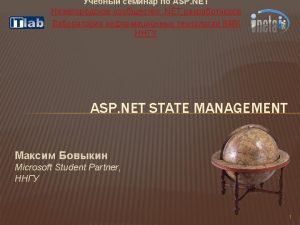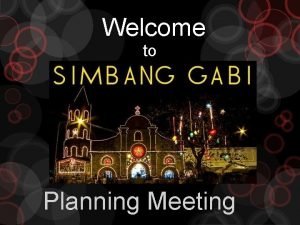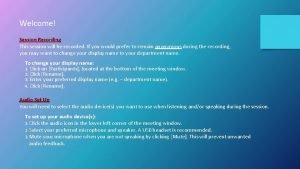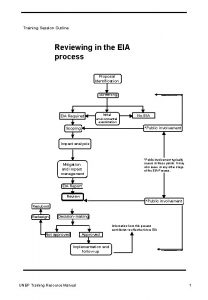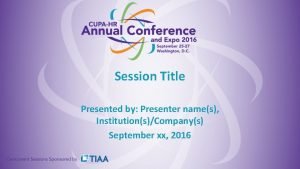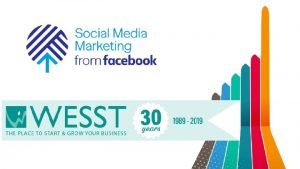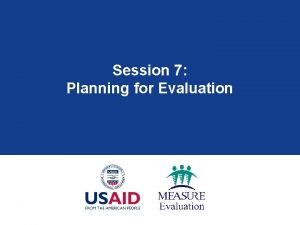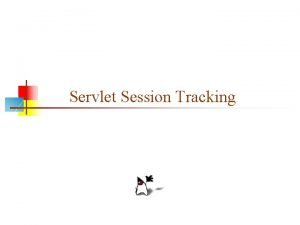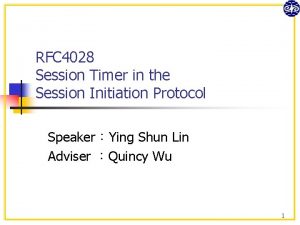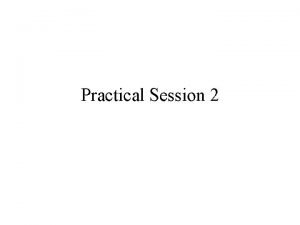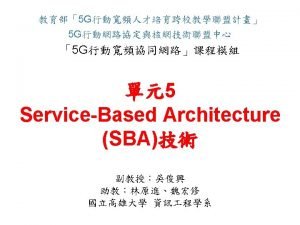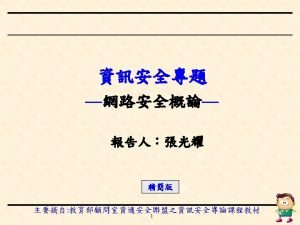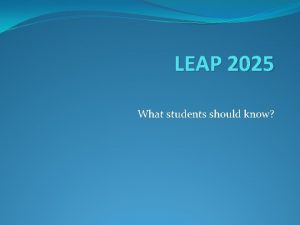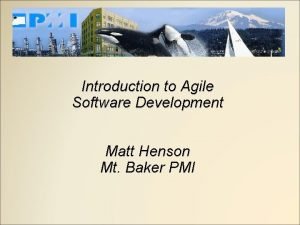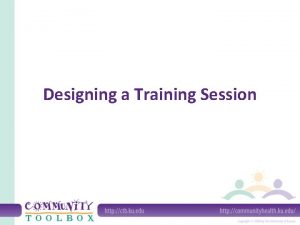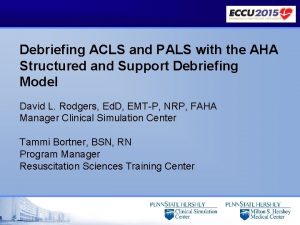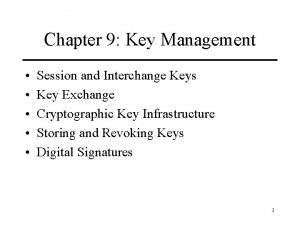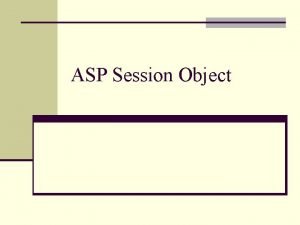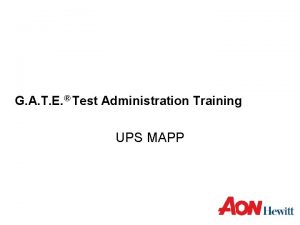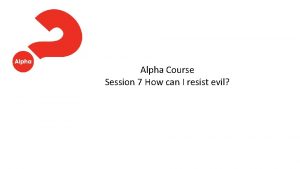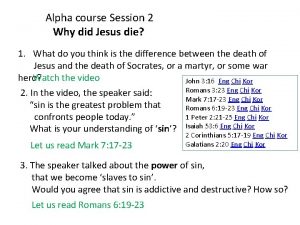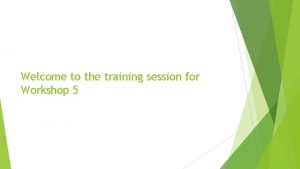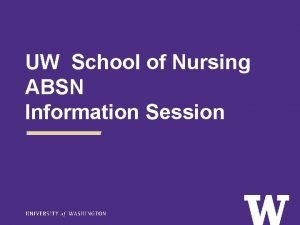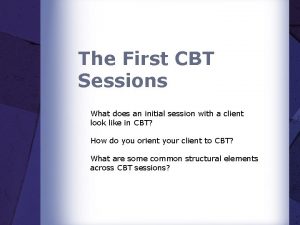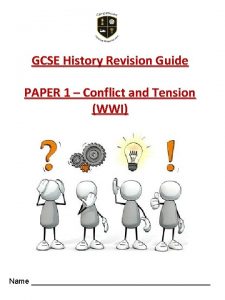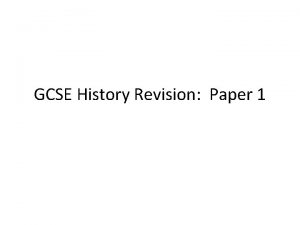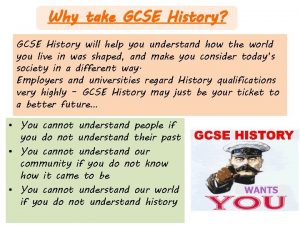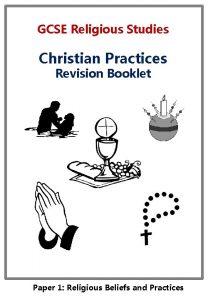i GCSE History Paper 1 Revision Session Which













































































































- Slides: 109

i. GCSE History Paper 1 Revision Session

Which nations do these men represent? British Prime Minister, Lloyd. George US President, Woodrow Wilson French Prime Minister, Georges Clemenceau

What were the aims of the ‘Big Three’? • The Big Three • Georges Clemenceau (Le Tigre) – wanted to cripple Germany. • Woodrow Wilson (the idealist) – wanted peace above all else and believed in the idea of ‘self-determination’. • David Lloyd George (the realist) – wanted to punish Germany but maintain good trade links.

What were the terms of the TOV? • The clauses of the Treaty of Versailles • The war guilt clause • Reparations (£ 6. 6 billion/£ 6, 600 million) • Territories (the Rhineland became demilitarised, Alsace-Lorraine was returned to France, the Saarland was run by the League of Nations, there was to be no Anschluss with Austria) • Armed forces (the army was limited to 100, 000 men, the navy was limited to 15, 000 men, conscription was banned, they were not allowed any armoured vehicles, submarines or aircraft, they could only have 6 battleships) • The League of Nations

What was the impact of the treaty on Germany? • German reaction/impact: • Kapp Putsch- 1920 Ø Attempt by Wolfgang Kapp to overthrow the Weimar Republic in retaliation to German signing of the TOV (failed, but inspired later uprisings in the Ruhr and weakened German government even further- perpetuated ‘stab in the back’ propaganda myth) • Hyperinflation – 1923 Ø The payment of reparations was partly responsible for the hyperinflation crisis that hit Germany • Crisis in the Ruhr- 1923 - 1925 Ø Germany’s failure to make reparations payments led to French and Belgian occupation of the Ruhr valley; this increased pressure on the German economy as the Ruhr was the centre of iron, steel and coal production. • Hitler takes power- 1933

Can the Treaty of Versailles be justified? YES • The Germans forced a very harsh treaty upon Russia in 1918 (the Treaty of Brest. Litovsk). Russia were forced to hand over land to Germany (1 million square miles). • Germany had encouraged the outbreak of war by offering their full support to Austria Hungary after the assassination of Franz Ferdinand. • Germany had caused deliberate destruction during the war e. g. the collapsing of French coal mines. The Treaty gave France access to German coal in the Saar for 15 years. • Germany did suffer losses but they still had 90% her original land 87. 5% of her population NO • Most countries took part in the signing of alliances, empire building and the arms race – all of which helped to cause the war. • The small army that Germany was left with after the Treaty left her exposed to an attack. It was not large enough to ensure national security. • The cost of reparations was never realistic for Germany to pay back £ 6. 6. The British economist, John Maynard Keynes, was part of the discussions and he pleaded for the amount to be reduced. • America refused to sign the Treaty because they thought it was too harsh.

ACTIVITY Big Points, Little Points • Sort the TOV terms into military, territorial, economic, and war guilt. • Write the main terms in the top box. • Write any supporting terms/smaller terms in the box below. Disregard any irrelevant information!

The Other Peace Treaties • Saint-Germain: The Treaty with Austria 1919 • Neuilly: The Treaty with Bulgaria, 1919 • Trianon: The Treaty with Hungary, 1920 • Sevres: The Treaty with Turkey, 1920 • Lausanne: Revising the Turkish Treaty, 1923

League of Nations • Four aims • • peace co-operation disarmament improved living and working conditions • Methods used to settle disputes • • • Moral condemnation Economic and financial sanctions (stopping trade etc. ) Military force

League of Nations Members • Membership France (1919 – 1945) Britain (1919 – 1945) Italy (1919 – 1937) Abyssinia! Japan (1919 – 1933) Manchuria! Germany (1926 – 1933) Not originally invited. Walked out of the disarmament conference. • The USSR (1934 – 1939) • Remember: the USA never joined! • • •

How was the League of Nations structured? The Refugees Committee The League has 4 main aims: • Discourage aggression • Encourage trade and business between countries • Encourage disarmament • Improve living and working conditions The Assembly Each country sent a representative The Council 4 Permanent members, each has a veto which means they can stop other council members ideas. Meet 5 times a year and in an emergency. It met once a year Job is to sort out disputes and stop further aggression. Decisions had to be unanimous (everyone had to agree) They can give 3 sanctions / punishments: This area voted on new members, budget & ideas put forward by Council The Permanent Court of International Justice If asked this would give judgement on who was guilty of causing a dispute • Condemn the aggressor (tell them to stop) • Economic: Stop trade • Military: Send in troops The Secretariat Keeps records of meetings and writes reports Helped refugees return to their original homes after a war. The Slavery Commission Worked to abolish slavery The Health Committee Dealt with dangerous diseases & worked to educate people about health and hygiene The International Labour Organisation Met once a year to try and improve working conditions e. g. hours, pay, introduction of trade union s

League of Nations - Structure • You don’t need to memorise the whole thing! • Focus on a few key points of weakness. • For example: • Each of the permanent members of the Council had a veto. They could stop the Council acting even if all of the other members agreed. • The Assembly only met once a year, which could lead to disputes being dealt with rather slowly. • The Permanent Court of International Justice had no way of enforcing its decisions in individual countries.

Border disputes in the 1920 s • • Vilna (1920) Upper Silesia (1921) Aaland Islands (1921) Corfu (1923) The Geneva Protocol Bulgaria (1925) (Think about which disputes were a SUCCESS and which were a FAILURE for the League of Nations; maybe plot them on a scale - I will put one on Edmodo for you. )

Vilna, 1920 • Poland Lithuania were two new states created by the post-war treaties. Vilna (now Vilnius) was made the capital of the new state of Lithuania, but its population was largely Polish. In 1920 a private Polish army simply took control of it. • Lithuania appealed for help. This was a crucial first 'test case' for the League. Both countries were members of the League. Poland was clearly the aggressor, though many people could see its case. The League protested to Poland, but Poland did not withdraw. The League was now stuck. • According to the Covenant it could have sent British and French troops to force the Poles out of Vilna. But it did not. The French were not prepared to upset Poland because they saw it as a possible ally against Germany in the future. Britain was not prepared to act alone and send troops right to the other side of Europe. • In the end the League did nothing. The Poles kept Vilna.

Upper Silesia, 1921 • Upper Silesia was an industrial region on the border between Germany and Poland It was inhabited by both German and Polish people. Both Germany and Poland wanted control of it, partly because of its rich iron and steel industry. In 1920, a PLEBISCITE was organised for Silesians to vote on which country they wished to join. French and British troops were sent to keep order at the polling booths. • The industrial areas voted mainly for Germany, the rural areas mainly for Poland. The League therefore divided the region along these lines, but it built in many safeguards to prevent future disputes. It safeguarded rail links between the two countries and made arrangements for water and power supplies from one side of the border to be supplied to the other. Both countries accepted the decision.

Aaland Islands, 1921 • Both Sweden and Finland wanted control of the Aaland Islands, which were midway between the two countries. Both countries were threatening to fight for them. They appealed to the League. • After studying the matter closely, the League said the islands should go to Finland. Sweden accepted the League's ruling and war was avoided.

Corfu, 1923 • One of the boundaries which had to be sorted out after the war was the border between Greece and Albania. The Conference of Ambassadors was given this job and it appointed an Italian general called Tellini to supervise it. On 27 August, while they were surveying the Greek side of the frontier area, Tellini and his team were ambushed and killed. • The Italian leader Mussolini was furious and blamed the Greek government for the murder. On 29 August he demanded that it pay compensation to Italy and execute the murderers. The Greeks, however, had no idea who the murderers were. On 31 August Mussolini bombarded and the occupied the Greek island of Corfu. Fifteen people were killed. Greece appealed to the League for help. • The situation was serious. It seemed like the events of 1914 which had triggered WW 1. Fortunately, the council was already in session, so the League acted swiftly. By 7 September it had prepared its judgement. It condemned Mussolini's actions. It also suggested that Greece pay compensation but the money be held by the League. The money would then be paid to Italy if, and when, Tellini's killers were found. • Officially, Mussolini accepted the League's decision. However, behind the scenes, he got to work on the Conference of Ambassadors and persuaded it to change the League's ruling. The Greeks had to apologise and pay compensation directly to Italy. On 27 September, Mussolini withdrew from Corfu boasting of his triumph.

Bulgaria, 1925 • Two years after Corfu, the League was tested again. In October 1925, Greek troops invaded Bulgaria after an incident on the border in which some Greek soldiers were killed. Bulgaria appealed for help. It also sent instructions to its army. • The League condemned the Greek action. It ordered Greece to pull out and pay compensation to Bulgaria. Faced with the disapproval of the major powers in the League, the Greeks obeyed although they did complain that there seemed to be one rule for the large states (such as Italy) and another for smaller ones (such as themselves).

League of Nations Work for a better world • The Refugee Committee – helped to return refugees home after WWI (about 400, 000 of them). • The Slavery Commission – worked to abolish slavery throughout the world (freeing about 200, 000 of them from Sierra Leone). • The Health Committee – tried to deal with dangerous diseases (it later became the World Heath Organisation). It got rid of leprosy and reduced malaria and yellow fever by controlling mosquitoes. • The International Labour Organisation campaigned for an 8 hour working day and a 48 hour working week BUT not everyone followed this as it would affect industries’ outputs.

Disarmament • KEY DATE: July 1932 (Total disarmament is not agreed upon. Germany walks out of the Disarmament Conference. ) • KEY DATE: June 1933 (Britain begins a disarmament plan that will lead to an agreement with Germany 2 years later, allowing Germany a navy as long as it is 35% smaller than the British navy. This agreement was made without consultation with the League; it went against the Treaty of Versailles. ) • KEY DATE: October 1933 (Hitler withdraws from the Disarmament Conference, and later, the League. ) • KEY DATE: 1934 (The Disarmament Conference ends as all nations begin to rearm. )

Wall St Crash & the League • Effects of the economic depression • In 1929, the Wall Street Crash caused the USA’s economy to collapse, damaging trade and industry and causing a devastating knock-on effect around Europe. • As American industries began to fail, they had to reduce their international trade. In three years, the USA lost $7 billion in trade after a 40% reduction in industry. America was the biggest international trader in the 1920 s, so it was only a matter of time before the economy of Europe was hit hard by their withdrawal from the trade market. Britain was hit hard by unemployment, just like Continental Europe. • This affected the methods the League of Nations could use to settle disputes; it had fewer resources to use as sanctions and individual countries were preoccupied with their economic struggles to deal with foreign

Crises in the 1930 s • By February 1932, Japan (a member of the League's Council) had invaded and conquered Manchuria. • It took the League nearly a year to send a commission and declare that Japan ought to leave - whereupon Japan left the League. • The League couldn't send an army, and it needed America's support to impose sanctions successfully. In the end, it did nothing. • In 1935, Italy invaded Abyssinia. • Although the Abyssinian emperor Haile Selassie went to the League himself to ask for help, all the League did was to ban arms sales, which did Abyssinia more harm than Italy. • A League commission offered Italy part of Abyssinia, but Italy invaded anyway. • Far from stopping Italy, Britain and France tried to make a secret pact to give Abyssinia to Italy.

‘The League had its greatest success in its humanitarian work. ’ How far do you agree with this statement? Explain your answer. - Plan a 10 mark answer to this question in pairs (on i. Pads/paper/walls) - How would you structure the answer? - What would your conclusion be?

Thinking Kit 0008020 Causes of World War Two Card Sort Wea k Nat League ions o 192 f 0 Long Term Short Term Trigger Event Sort these causes into long/short term and trigger event of 38 e r 9 u 1 l i Fa ment se a e C An pz p sch a in ec A va h us luss to si os n re 934 tri e s w i on lo a a 1 1 irt'hs r 3 t v e l 9 t m oefr aekn Hi 38 er 193 i G a 1 m pow Su 93 a, m 9 19 de ar 38 ten la nd h t i Cr w 8 s isi of 3 s 9 Re-militarization s u 1 l h Po c ria Rhineland 1936 s lnasn st e l l d i A u , in sa r SAep vas Ve t 1 ion f 939 of, yo t ea r T 19 19

Thinking Kit 0008020 Causes of World War Two Card Sort Wea k Nat League ions o 192 f 0 of 38 e r 9 u 1 l i Long Term Fa ment se a e C An pz p sch a in ec A va h us luss to si os n re 934 tri e s w i on lo a a 1 1 irt'hs r 3 t v e l 9 t m oefr aekn Hi 38 er 193 i G a 1 m pow Su 93 a, m 9 19 de Short Term Sort these ar 38 ten la IN PAIRS! causes nd h into t i Cr Enter this code on the Thinking Kit w 8 long/short s isi of 3 s 9 Re-militarization term and s app, and arrange the cards as u 1 l h trigger Po c ria Rhineland 1936 s instructed. s l a t e event l n nds, l A u in ai s A v r S ept asio Trigger Event Ve 193 n o As you arrange cards, take turns to f o f, 9 y t tell your partner everything you ea r T 19 remember about each of the events. 19

Long Term Short Term Trigger Event Treaty of Versailles 1919 Weak League of Nations 1920 Failure of Pact Nazi-Soviet Re-militarization Sudetenland of. Crisis German re. Anschluss with Hitler's rise to Czechoslovakia, appeasement 19391938 Rhineland 1938 1936 armament 1934 invasion of 1939 Austria 1938 power 1933 Poland, invasion of, Sept 1939


What was the USA like in the 1920 s? • How far did the US economy boom in the 1920 s? • What were the factors of the economic boom? • Why did some industries prosper in the boom while others did not? • Did all Americans benefit from the Boom? • What were the ‘Roaring Twenties’? • How widespread was intolerance in US society in the 1920 s? • Why was prohibition introduced and then later repealed? • How far did the roles of women

U. S. Economy, 1919 - 1929 110 Gross Domestic Product 100 90 80 70 1919 1920 1921 1918 – 1919: boom 1920 – 1921: readjustment 1922 – 1929: 1922 1923 1924 Year 1925 1926 1927 wartime economy and post-war recession and economic expansion and prosperity 1928 1929

The ‘boom’ happened in the 20 s because Americans…

L A C K P A N T S The ‘boom’ happened in the 20 s because Americans…

The ‘boom’ happened in the 20 s because Americans… Laissez-Faire A C K P A N T S

The ‘boom’ happened in the 20 s because Americans… Laissez-Faire Assembly line C K P A N T S

The ‘boom’ happened in the 20 s because Americans… Laissez-Faire Assembly line Credit K P A N T S

The ‘boom’ happened in the 20 s because Americans… Laissez-Faire Assembly line Credit Knowledge P A N T S

The ‘boom’ happened in the 20 s because Americans… Laissez-Faire Assembly line Credit Knowledge Position of USA (in war) A N T S

The ‘boom’ happened in the 20 s because Americans… Laissez-Faire Assembly line Credit Knowledge Position of USA (in war) Advertisement N T S

The ‘boom’ happened in the 20 s because Americans… Laissez-Faire Assembly line Credit Knowledge Position of USA (in war) Advertisement New consumer goods T S

The ‘boom’ happened in the 20 s because Americans… Laissez-Faire Assembly line Credit Knowledge Position of USA (in war) Advertisement New consumer goods Tariffs S

The ‘boom’ happened in the 20 s because Americans… Laissez-Faire Assembly line Credit Knowledge Position of USA (in war) Advertisement New consumer goods Tariffs Share confidence

Did the economic boom reach everybody in 1920 s?

Farming American farmers faced growing problems during the 1920 s. Thanks to new technologies, machines and techniques, farm production increased dramatically. This resulted in lower prices for their goods. At the same time, after the war, agricultural output in Europe recovered and the demand for American exports fell steeply. As a result, American farmers' incomes were drastically reduced and they fell into debt.

Heavy industry Industries such as coal and shipbuilding found themselves in a similar predicament to farming. Due to new mass production methods, these industries were producing a huge amount of goods. Combined with a fall in overseas demand for their goods, this led to over-production, lower prices and, as a result, a fall in wages for workers.

Racial minorities For the most part, black and immigrant workers missed out on the prosperity that had benefited other Americans. In industry and business, these ethnic minorities tended to be paid lower wages, live in the worst conditions and were usually the last to be hired for jobs and the first to be fired. In agriculture, black sharecroppers faced terrible problems. Usually working comparatively small plots of land, they did not have access to new technology to make their farms productive. Combined with the low prices paid for agricultural produce, black farmers often fell heavily into debt.

What was entertainment like in the 1920 s?

How far did the lives of Women change in the 1920 s?

Why were many Americans so anti-immigration?

Red Scare 1920 s US government greatly reduced the number of immigrants allowed in to the country. Fear of Communism and Anarchists. In April 1920, robbery in Braintee Massachusetts, stole 15, 000 and shot dead 2 staff. 1921, Sacco & Vanzetti arrested and sentenced to death in 1927. Sacco and Vanzetti were not just Italian immigrants but Anarchist too! Between 1919 -20 Around 10, 000 individuals Were deported.

Why were many Americans so anti-immigration? White Anglo Saxon Protestant s…

How widespread was intolerance? Why did the KKK rise up again in the 1920 s? Supremacy Ku Klux Klan WASPS Intolerance 1924 – 4. 5 million Members

Why was prohibition introduced and then later repealed? ? • • • • Prohibition was introduced January 1920 Prohibited any American from selling, making Or carrying any drink containing more than 0. 5% alcohol, most beers contain 5%. Strong campaign against alcohol led by some Pressure groups such as the Anti-Saloon League. ‘Demon Drink’, caused idleness, sickness, debt And family damage. Prohibition never worked, people wanted to drink and Were prepared to break the law. Gangs ran illegal bars called speakeasies, sold bootleg Alcohol smuggled from abroad. Moonshine, deaths 98 in 1920, 800 in 1926 Racketeering 1933 prohibition repealed.

https: //create. kahoot. it/? _ga=1. 80838423. 187795914. 1 449839033&device. Id=11719 d 94 -b 6 d 2 -495 b-9 d 50 e 6 fe 7 bd 387 c 7#quiz/faa 2 c 684 -16 f 1 -4740 -b 0 ee 529 ab 8 dfb 405

USA IN THE 1930 s • • Wall Street Crash Great Depression 1932 Election New Deal – 100 days – Alphabet Agencies – How successful – RE-READ YOUR COURSEWORK!

Conference and the Potsdam Conference?

The ‘Big Three’ of the Yalta Conference Remembe r him? ! Winston Churchill Prime Minister of Britain Aims: Free elections and democracy in Eastern Josef Stalin Leader of the USSR Aims: Russian influence in Eastern Europe Franklin Roosevelt President of the USA for a few months of 1945 before Truman took over. Aims: Russian support in

The Yalta Conference, Feb 1945 REMEMBER: The Yalta conference happened just before the end of the war to decide what to do with Germany after its defeat. OUTCOMES OF YALTA: 1) Germany was to be divided into four zones, controlled by Britain, France, the USA & the USSR.

The Yalta Conference, Feb 1945 REMEMBER: The Yalta conference happened just before the end of the war to decide what to do with Germany after its defeat. OUTCOMES OF YALTA: 2) Although Berlin (Germany’s capital) was in the soviet controlled zone, it would also be divided in four parts.

The Yalta Conference, Feb 1945 REMEMBER: The Yalta conference happened just before the end of the war to decide what to do with Germany after its defeat. OUTCOMES OF YALTA: 3) Nazi war criminals were to be hunted down and tried for their crimes.

The Yalta Conference, Feb 1945 REMEMBER: The Yalta conference happened just before the end of the war to decide what to do with Germany after its defeat. OUTCOMES OF YALTA: 4) Free elections were to be held in the states of Eastern Europe once they had been freed from German control.

The Yalta Conference, Feb 1945 REMEMBER: The Yalta conference happened just before the end of the war to decide what to do with Germany after its defeat. OUTCOMES OF YALTA: 5) Stalin agreed to enter the war against Japan in return for Soviet gains in the Far East.

The Yalta Conference, Feb 1945 REMEMBER: The Yalta conference happened just before the end of the war to decide what to do with Germany after its defeat. OUTCOMES OF YALTA: 6) A United Nations (UN) should be set up to replace the LON and to keep peace.

The ‘Big Three’ at the Potsdam Conference Josef Stalin Leader of the USSR Clement Attlee Prime Minister of Britain Harry Truman President of the USA


The Potsdam Conference, July 1945 This conference happened after Germany had lost the war. Although there were only 4 months between Yalta and Potsdam, lots had changed: • Roosevelt had died in April 1945, and was replaced by Truman who was far more suspicious of Stalin and unwilling to negotiate with him. • Churchill was defeated in an election and replaced by Clement Attlee. • Russian troops had taken over much of Eastern Europe and stayed there, without any free elections (against Yalta conference). • On 16 th July the USA had successfully tested the first atom bomb. It was clear they weren’t going to share the secret. Stalin became more suspicious. • The division of Germany into four and treatment of war criminals was confirmed at Potsdam.

The Potsdam Conference, July 1945 1) What were the main differences between the Yalta and Potsdam conferences? 2) How did these conferences affect the relationship between the USA & the USSR?


How much can you remember? ! In February 1945, the leaders of the USA, the USSR and Britain met at Yalta to decide what to do with Germany when the Second World War was over. Describe what was decided about Germany at the Yalta Conference. (4 marks)

The Truman Doctrine & The Marshall Plan VIDEO http: //www. bbc. co. uk/schools/gcsebitesize/history/mw h/ir 2/trumandoctrineandmarshallplan_video. shtml

The Berlin Blockade In 1945, the Allies decided to split Germany into four zones of occupation. The capital, Berlin, was also split into four zones. The USSR took huge reparations from its zone in eastern Germany, but Britain, France and America tried to improve conditions in their zones. In June 1948, Britain, France and America united their zones into a new country, West Germany. On 23 June 1948, they introduced a new currency, which they said would help trade. The next day, Stalin cut off all rail and road links to west Berlin - the Berlin Blockade. The west saw this as an attempt to starve Berlin into surrender, so they decided to supply west Berlin by air. The Berlin Blockade lasted 318 days. During this time, 275, 000 planes transported 1. 5 million tons of supplies and a plane landed every three minutes at Berlin's Templehof airport. On 12 May 1949, Stalin abandoned the blockade.

• https: //create. kahoot. it/? _ga=1. 125992077. 18779591 4. 1449839033&device. Id=11719 d 94 -b 6 d 2 -495 b-9 d 50 -e 6 fe 7 bd 387 c 7#quiz/316523 b 1 -d 7 a 6 -40 b 0 -afa 9310 d 48467955

What is NATO? • Stands for North Atlantic Treaty Organisation • Created on 4 th April 1949 – an alliance between USA and Western European countries • Shows USA/USSR have complete contempt for each other - no pretence • 12 countries join: USA, GB, France, Spain, Portugal, Italy, Belgium, Netherlands, Denmark, Norway, Canada, Iceland (Greece and Turkey join in 1952, West Germany joins in 1955) • Permits countries to use force for the purpose of self-defence against armed attack. (Military Alliance) • Marked significant militarisation of the Cold War conflict

Why did Truman set up NATO? • USSR announced that it had tested its first nuclear bomb so USA nuclear superiority was gone • USA look towards collective security as the main way to fight against Soviet aggression • Fear and tension heightened even more due to Communists taking over in China (Mao Tse-tung) in 1949 • Containment was still the US main foreign

Consequences of NATO being created? Results • USSR creates the Warsaw Pact on 14 th May 1955 • 8 countries join: Poland, Hungary, Czechoslovakia, Bulgaria, Albania, East Germany, Romania • Gave USSR more control within Eastern Europe

What was USA’s foreign policy up until 1949? t n e m n i a t n o C NSC 68 produced on the 12 th April 1950 How does this document influence US foreign policy?

WHO BECAME PRESIDENT OF THE USA IN 1953?

Eisenhower makes a speech called ‘the Domino speech’ where he says that the developing world is in danger of falling over-like Dominos-to Communist countries.

The People’s Democratic Republic of Korea (North Korea) was under the influence of the Soviet Union Kim Il Sung established a communist government in the North 1948 Korea was split along the 38 th parallel into North and South Syngman Rhee established a rightwing nationalist government in the South Why do the USA become involved in the of Korea (South Korea) was under the The Republic Korean War? of the USA influence

What is the USA’s biggest fear about Korea? June 25 th 1950 North Korean troops advanced over the 38 th parallel e d va n i a e r o K h t ? r a o e r N o d i K d h t y u h W So According to US foreign policy thinking who is behind the attack? According to US foreign policy how should the USA respond?

Cuba and USA • Despite the fact that Cuba gained its independence from Spain in 1898 after the Spanish-American War, the United States government ensured that it had some form of power and control over Cuban affairs. This was because of its location (just 99 miles off the coast of Florida) and was seen to be firmly in America’s sphere of influence. • From the beginning of the 1900 s, the USA invested heavily in the Cuban economy and made Cuba import goods from the USA (75% by 1914). The main businesses in Cuba were sugar and nickel mining. • Much of the sugar was grown on US-owned plantations and exported to the USA (80%). This meant Cuba was reliant on the export revenue it received from the US market. • In 1903, Cuba signed a treaty that ‘leased’ Guantanamo Bay to America for use as a naval station. • By the middle of the 20 th century, American businesses owned most of Cuba’s industry for example, railways, electricity production and the entire telephone system. • In short, Cuba was seen as an extension of the US and treated as an US colony and by the 1950 s a holiday destination for rich Americans.

Batista’s Cuba • Since 1933, Fulgencio Batista had been the leader of Cuba. • Fulgencio Batista had originally been elected as president, but made himself dictator of Cuba. There was no democratic process in Cuba and so the only way to bring about change was through armed revolution. • Many people were unhappy with Batista’s rule because his regime was corrupt, brutal and inefficient. Poverty was abundant, education was poor, and healthcare was extremely limited. • Social and economic problems and the influence of the US helped lead to the unrest of many Cubans. There was a small minority of rich Cubans who held all the power, while the majority of Cubans were very poor and had little to no power. Batista exploited Cuba's commercial interests, by negotiating lucrative relationships with the American mafia who controlled drug, gambling, and prostitution businesses in Havana. • • Under Batista, US interests in Cuba were protected and encouraged and in return Batista received economic and military help and support from the USA. • Batista’s unpopularity amongst the Cubans stretched from town to countryside but this had little effect on any elections as only politicians who were favourable to the USA would be elected. In return for their cooperation they would receive payments from American businessmen.

Power to the People • Soon, revolutionaries lead by Fidel Castro began to rise up against the government. Castro and his forces led an unsuccessful overthrow of the government in 1953 at the Moncardo Barracks. This was called the 26 th of July movement • The rebellion was crushed and Castro and his brother Raul were arrested and sentenced to 15 years in jail. • Castro was released in 1955 after serving only two years and fled to Mexico to put together a new group of rebel fighters. Here he met another revolutionary by the name of Che Guevara built up a force of well trained guerilla fighters and taking control of the Sierra Maestra mountains. • By the end of 1958, Castro’s forces were strong enough to pose a serious threat to Batista and on 1 st January 1959, Batista fled to the Dominican Republic while Castro began forming a new government. • Castro was a nationalist and wanted Cuba to be free from US influence. He set about arresting, imprisoning and executing Batista’s supporters who had been responsible for the repressive regime in Cuba. This caused tension with the US as they saw Castro illuminating close US allies. Many of Batista’s supporters fled to the US and campaigned to get the support for an anti-Castro invasion of Cuba.

Castro’s Promises Castro made himself dictator and promised to: • End American dominance over Cuban businesses • Abolish segregation between different races • Re-distribute the wealth evenly to all Cubans • Make every Cuban literate • To give all Cubans free healthcare and access to doctors • Key industry would be cheaper for Cubans e. g. electric and telephone • Casinos and hotels were closed down and the American mafia were forced to leave Cuba • He renegotiated trade agreements to increase the exports from Cuba to other countries across the world.

Impact on US • After the revolution, relations between the American government and Cuban government got worse and worse. • In 1961, Castro announced that Cuba would be adopting the Communist ideology; this frightened the USA because Cuba was so close. • Castro signed a trade agreement with Khrushchev giving Cuba $100 m in economic aid. He began importing weapons and technology in to Cuba from the Soviet Union. • US didn’t like Cuba having ties with the Soviet Union because they were involved in the Cold War. They saw Cuba as another satellite state under control by Moscow. • Americans who owned land businesses in Cuba lost their property. • Castro forced American civilians to leave Cuba.

Bay of Pigs & Cuban Missile Crisis • 1959 - Fidel Castro took power in Cuba. He nationalised American companies in Cuba. • In retaliation the US stopped all aid to Cuba, and all imports of Cuban sugar. Castro asked the Soviet Union for help and they became trading partners. Castro became a communist. • April 1961 - the CIA trained, armed and transported 1, 300 Cuban exiles to invade Cuba at the Bay of Pigs. They failed and Kennedy was humiliated. • October 1962 - American spy planes discovered suspected Soviet missile sites in Cuba. • America had missiles in Turkey, in range of the Soviet Union. It was the start of a crisis that took the world to the brink of a

How are these two maps different?

North Vietnam was ruled by Ho Chi Minh who was a communist and wanted a communist Vietnam. South Vietnam was ruled by Ngo Dinh Diem who was an anticommunist. • Vietnam used to be part of France's overseas empire. • When French forces were defeated in 1954 by the communists , the country was temporarily divided into North and South Vietnam at the Geneva Peace Conference. • Representatives at the conference (including representatives from the USA) agreed to a general election, for the whole of Vietnam,

Why would leaders in the USA be worried about the whole of Vietnam becoming Communist? Do you think the Domino Theory was convincing?

North Vietnam was ruled by Ho Chi Minh who was a communist and wanted a communist Vietnam. If Ho Chi Minh won the 1956 election, Vietnam would be a communist country like China already was. Leaders in the USA were worried that other countries would also become communist. America called this the 'Domino Theory'. South Vietnam was ruled by Ngo Dinh Diem who was an anticommunist.

In October 1955 Diem was officially elected president of South Vietnam. However, the elections were rigged, with 605, 000 people in Saigon (the capital) voting for Diem. Saigon only had a polulation of 450, 000. The July date for the election came and went. Diem, supported by the USA, refused to allow the election in South Vietnam. Diem knew that the USA would go on supporting him because he prevented a communist victory in the South. Diem's government was harsh, and he ruled as a dictator. He was only interested in hunting down supporters of the Vietminh and 're-educating' them inprison camps. Those who would not change their views were executed. Vieminh: a Communist group which fought for Vietnamese independence from French rule. Diem was a Catholic whilst most Vietnamese were Buddhists. He packed his government with Roman Catholic landowners. He persecuted Buddhists, even going as far as banning the flying of the Buddhist flag on Buddha's birthday. The Buddhist monk in the picture is Quang Duc who was 73 years old. In June 1963 he set himself alight as a protest against Diem's religious policy. Diem's sister-inlaw responded by saying she hoped for more such 'barbeques'. Diem took land from the peasants who were farming it and the time and gave it to his supporters. The landowners forced their peasant tenants to pay high taxes and even made them work for nothing at certain times of the year.

North Vietnam was ruled by Ho Chi Minh who was a communist and wanted a communist Vietnam. South Vietnam was ruled by Ngo Dinh Diem who was an anticommunist. If Ho Chi Minh won the 1956 election, Vietnam would be a communist country like China already was. Leaders in the USA were worried that other countries would also become communist. America called this the 'Domino Theory'. Diem was an unpopular leader because:

In 1963 and 1964 tension between North and South Vietnam increased and so did American involvement. However President Kennedy said he was determined that the USA would not ‘blunder into war, unclear about aims or how to get out again. ’ JFK was assassinated in 1963, his successor President Johnson was more prepared to commit the USA to full-scale conflict in Vietnam to prevent the spread of communism. In August 1964 North Vietnamese patrol boats opened fire on US ships. In a furious reaction, the US Congress passed the Tonkin Gulf Resolution. On March 8 th 1965 3500 US combat troops entered Vietnam. America was now at war. Tonkin Gulf Resolution = gave Pres. Johnson the power to ‘take all necessary measures to prevent further aggression and achieve peace and security. ’ it effectively meant Johnson could take the USA into full scale war if he felt necessary.

a) Describe what happened at the Gulf of Tonkin in 1964 (4) In 1964 the Gulf of Tonkin was attacked by North Vietnamese patrol boats. This led to the passing of the Tonkin Gulf Resolution by US Congress. The event convinced president Johnson to send US troops to Vietnam. 3500 US marines arrived in Vietnam which started the Vietnam war.

Why did America get involved in the Vietnam war? 1. President Eisenhower believed in something called the “Domino theory”. He was convinced that the USSR and China were trying to spread communism around the world. The Domino Theory stated that if one country in Asia fell to communism, then other countries would fall to communism as well. This was partly because communist countries had a duty to help others to become communist. 2. They got involved to stop the South Vietnam becoming communist specifically because over 40% of South Vietnam was controlled by the Viet Cong (South Vietnamese communist Guerrillas) • 3. The ARVN's (South Vietnamese Army) weakness It was obvious the South Vietnamese could not resist the Vietcong without help. In 1963, the American commander reported that the ARVN - the South Vietnamese army - were "ill-equipped local militia who more often than not were killed asleep in their defensive positions. ” US advisers believed that good government and an efficient, large-scale war would defeat the Vietcong. • 4. The “Tonkin Incident” in 1964. This was when a North Vietnamese torpedo boat attacked an American Destroyer, the USS Madox in the Gulf of Tonkin. This gave President Johnson the excuse that he

Why had America got so involved in the Vietnam war by the 1960 s? (6) Three reasons, fully explained!

TACTICS IN THE VIETNAM WAR Investigate the main tactics used in the Vietnam war

American tactics • Operation Rolling Thunder - Bombing N. Vietnamese towns to destroy morale • Search and Destroy - Looking for the Vietcong in villages. If Vietcong presence was suspected, the village was destroyed

American tactics continued… • Chemical weapons Napalm Agent Orange

The next two slides contain photos of people harmed by chemical weapons

Napalm • A fluid that burns through almost anything. The Americans hoped it would hit Vietcong bases. In fact, it often hit civilians. "Napalm is the most terrible pain you can imagine, " said Kim Phúc, a napalm bombing survivor known from a famous Vietnam War photograph. "Water boils at 100 degrees Celsius (212°F). Napalm generates temperatures of 800 (1, 500°F) to 1, 200 degrees Celsius (2, 200°F). "

Agent Orange • Destroyed crops and trees • Attacked the human body and led to birth defects

How did the North Vietnamese fight back? • Viet Cong • Guerrilla tactics • http: //www. youtube. com/watch? v=O _Sji 9 Oh. Au. I&feature=fvwrel

Vietcong tactics • Booby traps were cheap and effective • Aimed to kill and injure Americans • Spikes covered in excrement

The tunnel system

Ho Chi Minh Trail • A jungle path • 60 tonnes a day carried to the Vietcong in the south. • Essential to Vietnamese Victory

American tactics – fill this in from memory! Tactic Operation Rolling Thunder Search and Destroy Agent Orange Napalm What was it? Impact?

Viet Cong tactics – fill this in from memory! Tactic What was it? Impact? Booby Traps Tunnel system Ho Chi Minh Trail

4 marks

6 marks

10 marks
 How useful is this source
How useful is this source Aqa history paper 1
Aqa history paper 1 Revision passive
Revision passive Labelled diagram of the heart gcse
Labelled diagram of the heart gcse What is this piece called
What is this piece called Edexcel geography gcse checklist
Edexcel geography gcse checklist What is this
What is this Fire needs 3 things
Fire needs 3 things Product design revision
Product design revision Food technology revision
Food technology revision Gcse pe revision booklet
Gcse pe revision booklet Computer science component 1
Computer science component 1 Geography gcse revision notes
Geography gcse revision notes Catering gcse revision
Catering gcse revision Aqa maths gcse revision guide
Aqa maths gcse revision guide Gcse child development revision powerpoint
Gcse child development revision powerpoint Brown paper session
Brown paper session Geography paper 2 revision notes
Geography paper 2 revision notes Describe watershed
Describe watershed V$active_session_history
V$active_session_history Active session history
Active session history Sample design and technology gcse examination paper answers
Sample design and technology gcse examination paper answers Sample design and technology gcse examination paper answers
Sample design and technology gcse examination paper answers Www.technologystudent.com
Www.technologystudent.com Edexcel english language
Edexcel english language English language paper 2 transactional writing
English language paper 2 transactional writing Gcse edexcel english literature past papers
Gcse edexcel english literature past papers Aqa religious studies a level past papers
Aqa religious studies a level past papers World association of technology teachers
World association of technology teachers Gcse computer science paper 2
Gcse computer science paper 2 Gcse english language paper 1 question 2
Gcse english language paper 1 question 2 English general paper paper 2 comprehension
English general paper paper 2 comprehension Hand approach general paper
Hand approach general paper History edexcel past papers
History edexcel past papers How useful questions gcse history
How useful questions gcse history Edexcel gcse history crime and punishment exam questions
Edexcel gcse history crime and punishment exam questions Gcse history
Gcse history Gcse history coursework
Gcse history coursework Gcse history ccea
Gcse history ccea What is javax.servlet.servlet mcq
What is javax.servlet.servlet mcq Factors affecting software quality
Factors affecting software quality Ib history paper 1 rights and protest past papers
Ib history paper 1 rights and protest past papers Higher history paper 2
Higher history paper 2 Also history physical
Also history physical Used to trim pieces of fabric the two handles are the same
Used to trim pieces of fabric the two handles are the same Which paper towel is the strongest experiment
Which paper towel is the strongest experiment Session 0 windows
Session 0 windows Welcome to new session 2020-21
Welcome to new session 2020-21 Session
Session Skill 18: anticipate the topics
Skill 18: anticipate the topics Team norming session
Team norming session Session title examples
Session title examples Conference session title examples
Conference session title examples Session tracking in asp.net
Session tracking in asp.net Stateful session bean life cycle
Stateful session bean life cycle Multi product profit volume chart
Multi product profit volume chart Eis portal principal per session
Eis portal principal per session Ergonomicsl
Ergonomicsl Practical session meaning
Practical session meaning Multipicand
Multipicand Define session in php
Define session in php Pdp staff
Pdp staff Mentorship kickoff meeting
Mentorship kickoff meeting Joint application development jad
Joint application development jad Poster imrad
Poster imrad Learning action cells
Learning action cells Ece 329
Ece 329 Hkn review
Hkn review Breakout session questions
Breakout session questions Facilitate training session
Facilitate training session Javax.ejb.createexception jar
Javax.ejb.createexception jar Listening guide template
Listening guide template Ece 120 wiki
Ece 120 wiki Sample aba session notes
Sample aba session notes Session protocol data unit
Session protocol data unit Dro in aba
Dro in aba Session layer functions
Session layer functions Meditech suspend session icon
Meditech suspend session icon Alpha session 2
Alpha session 2 Asp net session state
Asp net session state Simbang gabi prayer
Simbang gabi prayer Meeting will begin shortly
Meeting will begin shortly This session will be recorded
This session will be recorded Training session outline
Training session outline Name of the session
Name of the session Instagram
Instagram Session 7
Session 7 Server.servlet.session.persistent
Server.servlet.session.persistent Rfc 4028
Rfc 4028 Practical session meaning
Practical session meaning 5g stack
5g stack Osi model
Osi model Session 1 research simulation task
Session 1 research simulation task Agile approach to documentation is
Agile approach to documentation is Coaching session agenda
Coaching session agenda Training session design
Training session design Gas debriefing tool
Gas debriefing tool Word 2016 session 2 post assessment
Word 2016 session 2 post assessment Webex teams breakout rooms
Webex teams breakout rooms Intechange keys
Intechange keys Cbt session structure
Cbt session structure Asp session object
Asp session object : https://gate-india.aon.com/candidate/l
: https://gate-india.aon.com/candidate/l Db
Db Alpha kappa alpha information session
Alpha kappa alpha information session Alpha course session 7
Alpha course session 7 Alpha session 2
Alpha session 2 Welcome to the training session
Welcome to the training session Uw absn
Uw absn First cbt session structure
First cbt session structure
